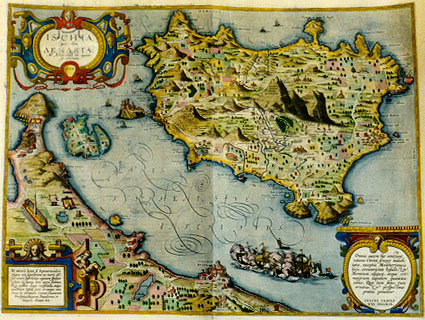Cartographica Neerlandica Background for Ortelius Map No. 142

Title: ISCHIA, | "quæ olim" | ÆNARIA. | "Ab Æneæ claße hic appulsa | sic nominata". | 1590. [Ischia, formerly called Ænaria, so called by the fleet of Æneas which landed here. 1590]. (Cartouche lower left corner with nine lines of text:) "Ne mireris lector; si Septentrionalem | plagam non superiorem (ut moris est) | sed contra,inferiorem regionem spectare | videas: Id namque data opera fecimus, | Quo utilior, magis necessaria, atque | amnior Insulæ pars, verusque eius | Situs in conspectu Caietæ, Cumarum, | Prochytæ, Baiarum, Puteolorum, et | Neapolis obviam iret". [Do not be astonished, reader, when you do not see the North at the top (as is the custom) but that it is to be seen at the bottom side; this we have done on purpose, so that the more useful, more necessary and attractive part of the island showing its true nature can truly be seen, as regards the location of Caieta, Cuma, Procida, Baiano, Pozzuoli and Naples.] (Centre top:) "Antrum in mari horrendum." [A terrible cave is in the sea here.] (Centre:) "Minera lapi:|dum mola:|rium celebris". (The ore for mill-stones is famous here.] (Centre:) "Locus terribilis | incendij saxorum | vulgo le cremate". [A frightening place because of its burning stones, commonly called la Cremata]. (Cartouche bottom right:) "Omnia autem hæc constant | ratione Circini semper indubi:|tata, exceptis Mediterraneis | locis, circumvicinis Insulis, & | Montium aliquot, atque cre:|matorum lapidum quantita:|tibus; Quæ tum situs, tum | ornatus, & perspectivæ | gratia ponuntur". | IVLIVS IASOLI:|NVS DESCRIB. [These matters have been established on the basis of the always indisputable views of Circinus, with the exception of the places situated more towards the interior, the surrounding islands and some mountains, and the amount of burning stones which are shown to demonstrate their location or in view of the perspective. Iulius Iasolinus has made this design].
Plate size: 363 x 484 mm
Scale: 1 : 100,000
Identification number: Ort 142 (Koeman/Meurer: 120, Karrow: 1/171, vdKrogtAN: 7550:31).
Occurrence in Theatrum editions and page number:
1590L4Addblank (100 copies printed) (identical in text and typesetting to 1592L but here without page number; last line, left aligned: Procida enim vocant.),
1591G4Addblank (75 copies printed) (last line, left aligned, in Gothic script like the entire text: men/etc.),
1592L83 (525 copies printed) (identical in text and typesetting with 1590L4Add but here with page number 83; last line, left aligned: Procida enim vocant.),
1595L88 (500 copies printed) (last line, left aligned: Elisij De balneis Puteolanis.),
1598F89 (525 copies printed) (last line, left aligned: tient de ceste isle.),
1598/1610/1613D61 (100 copies printed) (last line, centred like 3 lines above it, in Gothic script like the entire text: naem Procida),
1601L88 (200 copies printed) (last line, left aligned: Puteolanis.),
1602G91 (250 copies printed) (last line, left aligned, in Gothic script like the entire text: bidem ein See auß der tieffe herfür kommen/&c.),
1602S91 (250 copies printed) (last line, left aligned: Puteolanis.),
1603L91 (300 copies printed) (text, but not page number and typesetting, identical with 1609/1612L; last line, left aligned: videndus etiam Scipio Mazzella, ad libellum Elisij de balneis Puteolanis.),
1606E88 (300 copies printed) (last line, left aligned: "lysius" of the Bathes of "Puteoliæ".),
1608/1612I100 (300 copies printed) (last line, left aligned: zella, nel libro de bagni di Pozzuolo.),
1609/1612L101 (300 copies printed) (text, but not page number and typesetting, identical to 1603L; last line, left aligned: videndus etiam Scipio Mazzella, ad libellum Elisij de balneis Puteolanis.),
1609/1612/1641S101 (325 copies printed) (last line, left aligned: al librillo de Elisio.a donde el escriue De balneis Puteolanis.).
Approximate number of copies printed: 4050.
States: 142.1 as described.
142.2: after 1612S, date was removed.
Cartographic sources: Giulio Iasolino (abt. 1537-abt. 1622) in 1568 (the "Catalogus Auctorum" has 1586) wrote a book about Ischia and its beneficial baths which included a map of the island, engraved by Mario Cartario, which was faithfully followed here (Meurer p. 174-175).
For questions/comments concerning this page, please e-mail info@orteliusmaps.com.